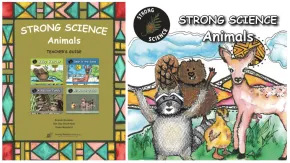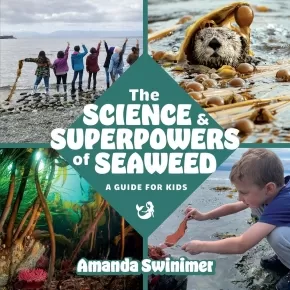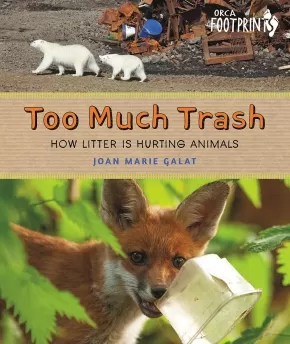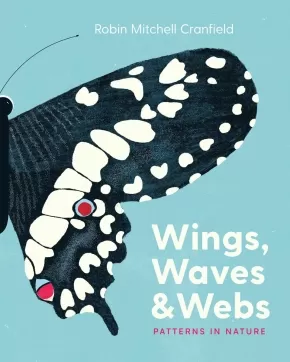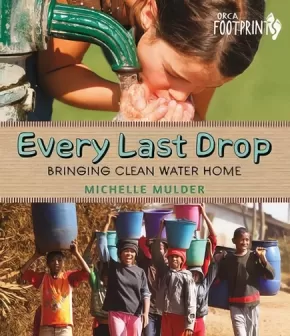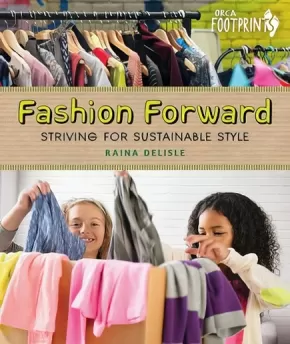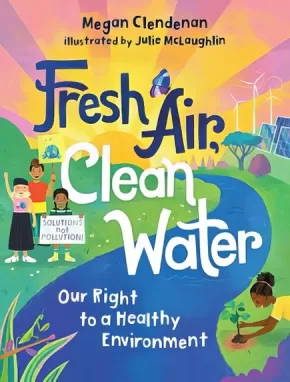
Environmental Awareness
46
-
60
of
130 Results;
Sort By
Go To
of 9
Strong Science - Animals: All About Raccoons
 $7.50
$7.50

Format:
Paperback
Grade Levels: Kindergarten; 1;
ISBN / Barcode: 9781771746199
Synopsis:
Synopsis:
This book is about raccoons.
Raccoons live where they can find food. Some live in forests. Others live in parks, in cities, or on farms.
What else do you know about raccoons?
Educator & Series Information
Recommended for grade 1 students, but may also be useful in kindergarten classrooms.
Strong Science - Animals is a language-based science series for primary students featuring animals that all Canadian students will recognize. Photographs and Indigenous artwork illustrate the series. Common learning objectives in science curricula across Canada are addressed, and suggestions for extending the learning to other curriculum areas, including Indigenous cultural awareness, language arts, math, and art, are included in the teacher’s guide. The sixteen books in this series are grouped into four levels that increase in complexity, designed to accommodate students with various reading abilities within a classroom. This feature facilitates the use of this series in literacy programs along with the Strong Readers series.
All About Raccoons is an EP4 (Early Primary 4) book in the Strong Science - Animals series. Font size decreases as language complexity and word count increase across levels: EP1 books have approximately 40 words, EP2 books have approximately 60 words, EP3 books have approximately 80 words, and EP4 books have approximately 100 words.
A teacher's guide for Strong Science - Animals is available: Strong Science - Animals: Teacher's Guide
Additional Information
16 Pages | 6.5" x 5.5" | Paperback | ISBN: 9781771746199
Strong Science - Animals: Baby Beaver
 $7.50
$7.50

Artists:
Format:
Paperback
Text Content Territories:
Indigenous Canadian;
Grade Levels: Kindergarten; 1;
ISBN / Barcode: 9781771746045
Synopsis:
Synopsis:
This book is about a baby beaver.
Beavers cut down trees.
Why do you think beavers cut down trees?
Educator & Series Information
Recommended for grade 1 students, but may also be useful in kindergarten classrooms.
Strong Science - Animals is a language-based science series for primary students featuring animals that all Canadian students will recognize. Photographs and Indigenous artwork illustrate the series. Common learning objectives in science curricula across Canada are addressed, and suggestions for extending the learning to other curriculum areas, including Indigenous cultural awareness, language arts, math, and art, are included in the teacher’s guide. The sixteen books in this series are grouped into four levels that increase in complexity, designed to accommodate students with various reading abilities within a classroom. This feature facilitates the use of this series in literacy programs along with the Strong Readers series.
Baby Beaver is an EP1 (Early Primary 1) book in the Strong Science - Animals series. Font size decreases as language complexity and word count increase across levels: EP1 books have approximately 40 words, EP2 books have approximately 60 words, EP3 books have approximately 80 words, and EP4 books have approximately 100 words.
A teacher's guide for Strong Science - Animals is available: Strong Science - Animals: Teacher's Guide
Authenticity Note: This book has received the Indigenous Text label because the author is Indigenous (Lakota) and the featured animal holds cultural significance in many Indigenous cultures. The engaging story provides factual information in an easy-to-read format for children to learn science concepts and build literacy skills. It promotes respect for animals and Mother Earth, and its illustrations communicate additional cultural information through Lakota symbolism and designs. Further cultural connections are identified in the teacher's guide. Refer to the guide to explore the book's Indigenous connections fully. It is up to readers to determine if the book will work as a stand-alone authentic Indigenous text for their purposes.
Additional Information
16 Pages | 6.5" x 5.5" | Paperback | ISBN: 9781771746045
Strong Science - Animals: Baby Deer
 $7.50
$7.50

Artists:
Format:
Paperback
Text Content Territories:
Indigenous Canadian;
Grade Levels: Kindergarten; 1;
ISBN / Barcode: 9781771746083
Synopsis:
Synopsis:
This book is about a baby deer.
Baby deer can swim and jump.
Have you seen a baby deer? Where was it?
Educator & Series Information
Recommended for grade 1 students, but may also be useful in kindergarten classrooms.
Strong Science - Animals is a language-based science series for primary students featuring animals that all Canadian students will recognize. Photographs and Indigenous artwork illustrate the series. Common learning objectives in science curricula across Canada are addressed, and suggestions for extending the learning to other curriculum areas, including Indigenous cultural awareness, language arts, math, and art, are included in the teacher’s guide. The sixteen books in this series are grouped into four levels that increase in complexity, designed to accommodate students with various reading abilities within a classroom. This feature facilitates the use of this series in literacy programs along with the Strong Readers series.
Baby Duck is an EP1 (Early Primary 1) book in the Strong Science - Animals series. Font size decreases as language complexity and word count increase across levels: EP1 books have approximately 40 words, EP2 books have approximately 60 words, EP3 books have approximately 80 words, and EP4 books have approximately 100 words.
A teacher's guide for Strong Science - Animals is available: Strong Science - Animals: Teacher's Guide
Authenticity Note: This book has received the Indigenous Text label because the author is Indigenous (Lakota) and the featured animal holds cultural significance in many Indigenous cultures. The engaging story provides factual information in an easy-to-read format for children to learn science concepts and build literacy skills. It promotes respect for animals and Mother Earth, and its illustrations communicate additional cultural information through Lakota symbolism and designs. Further cultural connections are identified in the teacher's guide. Refer to the guide to explore the book's Indigenous connections fully. It is up to readers to determine if the book will work as a stand-alone authentic Indigenous text for their purposes.
Additional Information
16 Pages | 6.5" x 5.5" | Paperback | ISBN: 9781771746083
Strong Science - Animals: Baby Duck
 $7.50
$7.50

Artists:
Format:
Paperback
Text Content Territories:
Indigenous Canadian;
Grade Levels: Kindergarten; 1;
ISBN / Barcode: 9781771746090
Synopsis:
Synopsis:
This book is about a baby duck.
Baby ducks come out of eggs.
Have you seen a baby duck? Where was it?
Educator & Series Information
Recommended for grade 1 students, but may also be useful in kindergarten classrooms.
Strong Science - Animals is a language-based science series for primary students featuring animals that all Canadian students will recognize. Photographs and Indigenous artwork illustrate the series. Common learning objectives in science curricula across Canada are addressed, and suggestions for extending the learning to other curriculum areas, including Indigenous cultural awareness, language arts, math, and art, are included in the teacher’s guide. The sixteen books in this series are grouped into four levels that increase in complexity, designed to accommodate students with various reading abilities within a classroom. This feature facilitates the use of this series in literacy programs along with the Strong Readers series.
Baby Duck is an EP1 (Early Primary 1) book in the Strong Science - Animals series. Font size decreases as language complexity and word count increase across levels: EP1 books have approximately 40 words, EP2 books have approximately 60 words, EP3 books have approximately 80 words, and EP4 books have approximately 100 words.
A teacher's guide for Strong Science - Animals is available: Strong Science - Animals: Teacher's Guide
Authenticity Note: This book has received the Indigenous Text label because the author is Indigenous (Lakota) and the featured animal holds cultural significance in many Indigenous cultures. The engaging story provides factual information in an easy-to-read format for children to learn science concepts and build literacy skills. It promotes respect for animals and Mother Earth, and its illustrations communicate additional cultural information through Lakota symbolism and designs. Further cultural connections are identified in the teacher's guide. Refer to the guide to explore the book's Indigenous connections fully. It is up to readers to determine if the book will work as a stand-alone authentic Indigenous text for their purposes.
Additional Information
16 Pages | 6.5" x 5.5" | Paperback | ISBN: 9781771746090
Strong Science - Animals: Baby Raccoon
 $7.50
$7.50

Artists:
Format:
Paperback
Text Content Territories:
Indigenous Canadian;
Grade Levels: Kindergarten; 1;
ISBN / Barcode: 9781771746052
Synopsis:
Synopsis:
This book is about a baby raccoon.
Raccoons can climb trees.
Why do you think raccoons climb trees?
Educator & Series Information
Recommended for grade 1 students, but may also be useful in kindergarten classrooms.
Strong Science - Animals is a language-based science series for primary students featuring animals that all Canadian students will recognize. Photographs and Indigenous artwork illustrate the series. Common learning objectives in science curricula across Canada are addressed, and suggestions for extending the learning to other curriculum areas, including Indigenous cultural awareness, language arts, math, and art, are included in the teacher’s guide. The sixteen books in this series are grouped into four levels that increase in complexity, designed to accommodate students with various reading abilities within a classroom. This feature facilitates the use of this series in literacy programs along with the Strong Readers series.
Baby Raccoon is an EP1 (Early Primary 1) book in the Strong Science - Animals series. Font size decreases as language complexity and word count increase across levels: EP1 books have approximately 40 words, EP2 books have approximately 60 words, EP3 books have approximately 80 words, and EP4 books have approximately 100 words.
A teacher's guide for Strong Science - Animals is available: Strong Science - Animals: Teacher's Guide
Authenticity Note: This book has received the Indigenous Text label because the author is Indigenous (Lakota) and the featured animal holds cultural significance in many Indigenous cultures. The engaging story provides factual information in an easy-to-read format for children to learn science concepts and build literacy skills. It promotes respect for animals and Mother Earth, and its illustrations communicate additional cultural information through Lakota symbolism and designs. Further cultural connections are identified in the teacher's guide. Refer to the guide to explore the book's Indigenous connections fully. It is up to readers to determine if the book will work as a stand-alone authentic Indigenous text for their purposes.
Additional Information
16 Pages | 6.5" x 5.5" | Paperback | ISBN: 9781771746052
Strong Science - Animals: Deer in the Snow
 $7.50
$7.50

Artists:
Format:
Paperback
Text Content Territories:
Indigenous Canadian;
Grade Levels: Kindergarten; 1;
ISBN / Barcode: 9781771746168
Synopsis:
Synopsis:
This story is about how deer find food when it snows.
There are four seasons in the year: winter, spring, summer, and fall. Which season is this story about?
Educator & Series Information
Recommended for grade 1 students, but may also be useful in kindergarten classrooms.
Strong Science - Animals is a language-based science series for primary students featuring animals that all Canadian students will recognize. Photographs and Indigenous artwork illustrate the series. Common learning objectives in science curricula across Canada are addressed, and suggestions for extending the learning to other curriculum areas, including Indigenous cultural awareness, language arts, math, and art, are included in the teacher’s guide. The sixteen books in this series are grouped into four levels that increase in complexity, designed to accommodate students with various reading abilities within a classroom. This feature facilitates the use of this series in literacy programs along with the Strong Readers series.
Deer in the Snow is an EP3 (Early Primary 3) book in the Strong Science - Animals series. Font size decreases as language complexity and word count increase across levels: EP1 books have approximately 40 words, EP2 books have approximately 60 words, EP3 books have approximately 80 words, and EP4 books have approximately 100 words.
A teacher's guide for Strong Science - Animals is available: Strong Science - Animals: Teacher's Guide
Authenticity Note: This book has received the Indigenous Text label because the author is Indigenous (Lakota) and the featured animal holds cultural significance in many Indigenous cultures. The engaging story provides factual information in an easy-to-read format for children to learn science concepts and build literacy skills. It promotes respect for animals and Mother Earth, and its illustrations communicate additional cultural information through Lakota symbolism and designs. Further cultural connections are identified in the teacher's guide. Refer to the guide to explore the book's Indigenous connections fully. It is up to readers to determine if the book will work as a stand-alone authentic Indigenous text for their purposes.
Additional Information
16 Pages | 6.5" x 5.5" | Paperback | ISBN: 9781771746168
Strong Science - Animals: Mother and Baby Raccoons
 $7.50
$7.50

Artists:
Format:
Paperback
Text Content Territories:
Indigenous Canadian;
Grade Levels: Kindergarten; 1;
ISBN / Barcode: 9781771746137
Synopsis:
Synopsis:
This story is about the home mother raccoon makes in a tree for her babies. The home is called a den.
There are four seasons in the year: winter, spring, summer, and fall. Which season is this story about?
Educator & Series Information
Recommended for grade 1 students, but may also be useful in kindergarten classrooms.
Strong Science - Animals is a language-based science series for primary students featuring animals that all Canadian students will recognize. Photographs and Indigenous artwork illustrate the series. Common learning objectives in science curricula across Canada are addressed, and suggestions for extending the learning to other curriculum areas, including Indigenous cultural awareness, language arts, math, and art, are included in the teacher’s guide. The sixteen books in this series are grouped into four levels that increase in complexity, designed to accommodate students with various reading abilities within a classroom. This feature facilitates the use of this series in literacy programs along with the Strong Readers series.
Mother and Baby Raccoons is an EP3 (Early Primary 3) book in the Strong Science - Animals series. Font size decreases as language complexity and word count increase across levels: EP1 books have approximately 40 words, EP2 books have approximately 60 words, EP3 books have approximately 80 words, and EP4 books have approximately 100 words.
A teacher's guide for Strong Science - Animals is available: Strong Science - Animals: Teacher's Guide
Authenticity Note: This book has received the Indigenous Text label because the author is Indigenous (Lakota) and the featured animal holds cultural significance in many Indigenous cultures. The engaging story provides factual information in an easy-to-read format for children to learn science concepts and build literacy skills. It promotes respect for animals and Mother Earth, and its illustrations communicate additional cultural information through Lakota symbolism and designs. Further cultural connections are identified in the teacher's guide. Refer to the guide to explore the book's Indigenous connections fully. It is up to readers to determine if the book will work as a stand-alone authentic Indigenous text for their purposes.
Additional Information
16 Pages | 6.5" x 5.5" | Paperback | ISBN: 9781771746137
Strong Science - Animals: The Ducks Fly Away
 $7.50
$7.50

Artists:
Format:
Paperback
Text Content Territories:
Indigenous Canadian;
Grade Levels: Kindergarten; 1;
ISBN / Barcode: 9781771746175
Synopsis:
Synopsis:
This story begins with the ducks seeing the leaves on the trees turning red and yellow. How do you think this story ends?
There are four seasons in the year: winter, spring, summer, and fall. Which season is this story about?
Educator & Series Information
Recommended for grade 1 students, but may also be useful in kindergarten classrooms.
Strong Science - Animals is a language-based science series for primary students featuring animals that all Canadian students will recognize. Photographs and Indigenous artwork illustrate the series. Common learning objectives in science curricula across Canada are addressed, and suggestions for extending the learning to other curriculum areas, including Indigenous cultural awareness, language arts, math, and art, are included in the teacher’s guide. The sixteen books in this series are grouped into four levels that increase in complexity, designed to accommodate students with various reading abilities within a classroom. This feature facilitates the use of this series in literacy programs along with the Strong Readers series.
The Ducks Fly Away is an EP3 (Early Primary 3) book in the Strong Science - Animals series. Font size decreases as language complexity and word count increase across levels: EP1 books have approximately 40 words, EP2 books have approximately 60 words, EP3 books have approximately 80 words, and EP4 books have approximately 100 words.
A teacher's guide for Strong Science - Animals is available: Strong Science - Animals: Teacher's Guide
Authenticity Note: This book has received the Indigenous Text label because the author is Indigenous (Lakota) and the featured animal holds cultural significance in many Indigenous cultures. The engaging story provides factual information in an easy-to-read format for children to learn science concepts and build literacy skills. It promotes respect for animals and Mother Earth, and its illustrations communicate additional cultural information through Lakota symbolism and designs. Further cultural connections are identified in the teacher's guide. Refer to the guide to explore the book's Indigenous connections fully. It is up to readers to determine if the book will work as a stand-alone authentic Indigenous text for their purposes.
Additional Information
16 Pages | 6.5" x 5.5" | Paperback | ISBN: 9781771746175
Teacher Resource Bundle: Strong Science - Animals
 $135.00 $150.00
$135.00 $150.00

Text Content Territories:
Indigenous Canadian; First Nations; Sioux; Lakota; Hunkpapa;
Grade Levels: Kindergarten; 1;
ISBN / Barcode: 9781771746663
Synopsis:
Synopsis:
This bundle includes one copy of each of the 16 Strong Science - Animals titles and the accompanying Strong Science: Animals - Teacher's Guide.
About the Strong Science - Animals Series
Strong Science - Animals is a language-based science series for primary students featuring animals that all Canadian students will recognize. Photographs and Indigenous artwork illustrate the series. Common learning objectives in science curricula across Canada are addressed, and suggestions for extending the learning to other curriculum areas, including Indigenous cultural awareness, language arts, math, and art, are included in the teacher’s guide. The sixteen books in this series are grouped into four levels that increase in complexity, designed to accommodate students with various reading abilities within a classroom. This feature facilitates the use of this series in literacy programs along with the Strong Readers series.
Books in this series are divided into four levels: Early Primary 1 (EP1); Early Primary 2 (EP2); Early Primary 3 (EP3); Early Primary 4 (EP4). Font size decreases as language complexity and word count increase across levels: EP1 books have approximately 40 words, EP2 books have approximately 60 words, EP3 books have approximately 80 words, and EP4 books have approximately 100 words.
Each book is 16 pages, 6.5" x 5.5", and paperback
About the Strong Science - Animals: Teacher's Guide
This teacher’s guide supports a language-based Science unit for early primary classrooms, using the sixteen titles in Strong Nations Publishing’s Strong Science - Animals series.
The unit introduces early primary students to four easily recognizable animals that live in or near many communities in Canada: beaver, black-tailed deer, mallard duck, and raccoon. While learning about the animals, students will gain knowledge and skills mandated by Ministry of Education Science curricula in Canadian provinces and territories.
In addition, this teacher’s guide addresses other curriculum areas— Language Arts, Math, Social Studies, and Art—and provides information to help develop an appreciation for and understanding of Indigenous cultures.
This teacher-friendly, comprehensive teacher’s guide provides:
• lesson plans to introduce the books in the Strong Science - Animals series;
• lesson plans to address knowledge and skills common to Canadian Science curricula;
• activities to integrate the unit across the curriculum;
• activities to wrap up the unit
The teacher's guide is 170 Pages, 8.5" x 11", and coil bound
Additional Information
Teacher Resource Bundle ISBN: 9781771746663
The Science and Superpowers of Seaweed: A Guide for Kids
$24.95
Format:
Paperback
ISBN / Barcode: 9781990776199
Synopsis:
Synopsis:
A middle-grade and family-friendly introduction to the enchanting world of seaweed.
Young readers will be delighted to learn about the wonderful, watery world of seaweed, where emerald-green kelp forests grow as tall as trees and rainbow seaweeds shimmer like gemstones in the sunlight. Seaweed can be fun too, providing tasty snacks like nori crisps and cool things to do: hunt for dead man’s fingers to squeeze like a squirt gun, have a popping contest with rockweed or make seaweed art. Seaweeds are also critical to the health of the planet—they produce most of the oxygen we need to breathe, help to keep the earth cool and provide habitat for sea creatures. And they're full of healthy vitamins and have more minerals than any other food!
This colourful, activity-packed book explores the science of seaweed while showing how to sustainably harvest and use it, and providing many fun facts about marine plants and animals. It is a unique field guide, featuring seaweeds from both Atlantic and Pacific oceans and showcasing the beautiful and vital ecosystems of the coasts, and is sure to inspire curious beachcombers of all ages.
Educator Information
Recommended for ages 6 to 12.
Additional Information
168 pages | 8.50" x 8.50" | Paperback
Too Much Trash: How Litter Is Hurting Animals
$21.95
Format:
Hardcover
ISBN / Barcode: 9781459831827
Synopsis:
Synopsis:
Litter is not only an eyesore but a serious threat to animals and their habitats. We can all work together to keep the planet healthy and clean.
Did you know that gum on the sidewalk is litter? Even a banana peel that is thrown in a ditch is litter. Trash poses a threat to animals everywhere, including pets, farm animals and wildlife. They can get injured or trapped in the litter and even eat garbage that makes them sick.
In Too Much Trash: How Litter Is Hurting Animals, we discover how garbage ends up everywhere—from city streets and the wilderness to farmland and the ocean. But there's good news: litter is a problem everyone can help prevent. Around the world, kids and adults are finding ways to take out the trash. Find out how you can help clean up the planet for all species.
Reviews
“Lively design layouts with discrete, digestible bits of text make the book accessible and inspiring. Showing how refuse harms humans and other animals, this work should move readers to act.” — Kirkus Reviews
Educator & Series Information
This book is part of the Orca Footprint series. Kids today inhabit a world full of complex—and often mystifying—environmental issues. Orca Footprints aim to help kids answer their questions about the state of the natural world with well-researched, simply-expressed information and powerful images. With topics such as food production, water, cycling and sustainable energy, these books will inspire kids to take action.
Recommended for ages 9-12.
Additional Information
48 pages | 8.00" x 9.50" | Hardcover
Wings, Waves & Webs: Patterns in Nature
$22.95
Artists:
Format:
Hardcover
ISBN / Barcode: 9781771646765
Synopsis:
Synopsis:
A visually stunning introduction to patterns found in nature. Perfect for early STEM learning in preschool and kindergarten.
From the dots on a ladybug to the spiral on a snail, patterns in nature can be found anywhere. This simple and playful concept book introduces the littlest of readers to both math and nature while engaging their creative potential. By the end, kids will be able to identify:
- Spots and stripes
- Spirals and symmetry
- Waves and honeycombs
- And more
After learning about key patterns, the book's final page—a striking sunflower—will inspire kids to find patterns for themselves. Vibrant and immersive, Wings, Waves & Webs invites young children to discover the beauty of the world around them.
Educator Information
Recommended for ages 2 to 6.
Curriculum Connections: Patterning, Geometry, Nature, Art and Design
Additional Information
36 pages | 10.00" x 8.00" | Hardcover
Every Last Drop: Bringing Clean Water Home
$14.95
Format:
Paperback
ISBN / Barcode: 9781459835108
Synopsis:
Synopsis:
In the developed world, if you want a drink of water you just turn on a tap or open a bottle. But for millions of families worldwide, finding clean water is a daily challenge, and kids are often the ones responsible for carrying water to their homes. Every Last Drop looks at why the world’s water resources are at risk and how communities around the world are finding innovative ways to quench their thirst and water their crops. Maybe you’re not ready to drink fog, as they do in Chile, or use water made from treated sewage, but you can get a low-flush toilet, plant a tree, protect a wetland or just take shorter showers. Every last drop counts!
Reviews
"This engaging book takes on the important task of explaining clean drinking water to middle school students...The writing style is a very accessible mixture of personal travel stories and interesting facts ..It can be hard to find good books on sustainability issues for middle school students. This well-written book will be a welcome addition to any classroom or library collection. It will support any research on water usage and will be popular with students interested in getting involved with environmental issues. Highly Recommended." — CM Magazine
"Mulder’s book will make readers stop and calculate...Lavishly illustrated with everything from woodcuts to photographs, the book is far from downbeat and scolding...Mulder writes with a clean, no-nonsense style...Informative, attractive and alarming—readers will think twice before leaving the water running as they brush their teeth." — Kirkus Reviews
Educator & Series Information
Recommended for ages 9 to 12.
This book is part of the Orca Footprints series. Kids today inhabit a world full of complex—and often mystifying—environmental issues. Orca Footprints aim to help kids answer their questions about the state of the natural world with well-researched, simply-expressed information and powerful images. With topics such as food production, water, cycling and sustainable energy, these books will inspire kids to take action.
Additional Information
48 pages | 8.00" x 9.50" | Paperback
Fashion Forward: Striving for Sustainable Style
$19.95
Format:
Hardcover
ISBN / Barcode: 9781459825802
Synopsis:
Synopsis:
Fashion can be fun, but it can also hurt people, animals and the planet.
Fashion Forward: Striving for Sustainable Style goes behind the glitz and glamour to explore the social and environmental issues within the fashion industry. It looks at the history of fashion, from why humans started wearing clothes to the birth of consumerism to the explosion of fast fashion and fashion’s footprint. The book introduces readers to the innovative people, companies and organizations that are taking positive action on fashion. Kids will discover how to make ethical choices and become fashion heroes for the future. There are easy ways we can help transform the fashion industry and still look stylish at the same time!
Reviews
“This book will inform and engage the middle school readers for whom it is written as well as younger and older readers looking for sustainable alternatives to fast fashion, and it will encourage all readers to make a difference by thinking critically before making clothing decisions. Highly Recommended.” — CM: Canadian Review of Materials
“A comprehensive overview...Despite its small size, this book contains a wealth of information and will help young consumers better understand the 4 R's of ethical fashion: research, repurpose, repair, rent! Highly Recommended.” — School Library Connection
Educator & Series Information
Recommended for ages 9 to 12.
This book is part of the Orca Footprint series.
Additional Information
56 pages | 8.00" x 9.50" | Hardcover
Fresh Air, Clean Water: Our Right to a Healthy Environment
$26.95
Artists:
Format:
Hardcover
ISBN / Barcode: 9781459826793
Synopsis:
Synopsis:
Everyone depends on clean air to breathe, safe water to drink and healthy soil for growing food. But what if your drinking water is dangerous, your air is polluted and your soil is toxic?
What can you do about that? Do you have the right to demand change?
Fresh Air, Clean Water: Defending Our Right to a Healthy Environment explores the connections between our environment and our health, and why the right to live in a healthy environment should be protected as a human right. The book features profiles of kids around the world who are taking action and important environmental rights court cases. Hear the powerful stories of those fighting for change.
Reviews
“A forceful and informative handbook on environmental justice, accessible enough to strike a chord with young readers.” — Kirkus Reviews
“A worthy purchase where readers enjoy a personal approach to science instruction.”— Booklist
Educator & Series Information
Recommended for ages 9 to 12.
This book is part of the Orca Think series.
A free, downloadable activitiy sheet is available: Activity Sheet - Fresh Air, Clean Water: Our Right to a Healthy Environment
Additional Information
102 pages | 7.00" x 9.00" | Colour Photographs | Hardcover
Sort By
Go To
of 9











